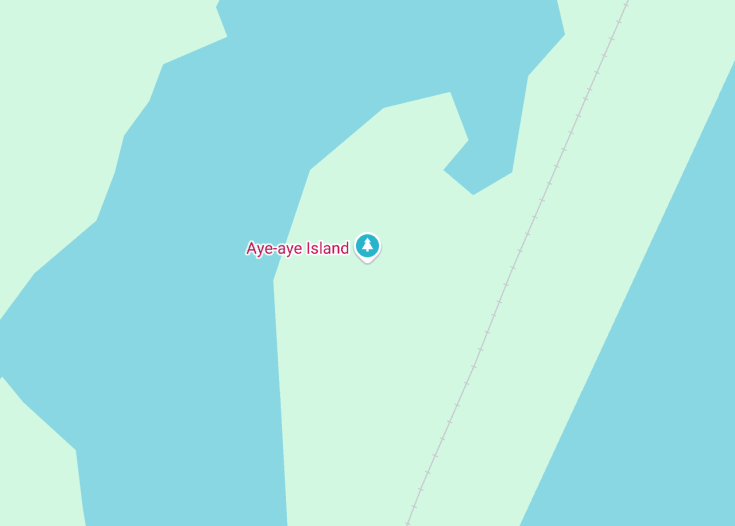Nestled on the northeastern coast of Madagascar, Aye-aye Island National Park is a unique sanctuary dedicated to the conservation of the rare and intriguing Aye-aye lemur. Beyond its conservation efforts, the park offers a breathtaking landscape of dense rainforests, rugged coastlines, and rich biodiversity.
Visitors are treated to a unique blend of ecological education and hands-on environmental preservation initiatives. This remote destination provides an unbeatable opportunity for wildlife enthusiasts and eco-tourists to immerse themselves in one of the world’s most elusive natural environments.
To make the most out of your visit, ensure you have comfortable hiking gear and protection against rain. The park’s trails can be quite challenging and weather unpredictable.
Consider hiring a local guide. Not only will this support the local community, but the insights and knowledge shared by these experts will greatly enhance your understanding of the park’s unique ecosystem and resident species.
Aye-aye Island National Park: A Pristine Natural Reserve
Located off the northeastern coast of Madagascar, Aye-aye Island National Park is a sanctuary primarily known for its unique wildlife and breathtaking landscapes. This park, named after the elusive Aye-aye lemur, encompasses a rich mosaic of tropical forests, rugged coastline, and secluded beaches, offering an unmatched experience for nature enthusiasts and adventure seekers alike.
As a vital conservation area, it plays a crucial role in protecting numerous endemic species that are native only to Madagascar. Visitors can look forward to not only potentially spotting the mysterious Aye-aye in its natural habitat but also enjoying the untouched beauty of one of the world’s most extraordinary biodiversity hotspots.
Whether it’s hiking through dense rainforests or exploring the vibrant marine life that surrounds the island, Aye-aye Island National Park serves as a powerful reminder of the natural treasures our planet holds.
Exploring the Wilds of Aye-aye Island
Aye-aye Island National Park offers a plethora of activities geared towards eco-tourism and wildlife observation. One of the main attractions is guided nocturnal tours where visitors have the opportunity to witness the Aye-aye lemur in action, as these creatures are mostly active at night.
Day hikes across different trails allow tourists to explore the diverse flora and fauna safeguarded within the park. For those interested in marine life, snorkeling and diving around the coral reefs present an excellent chance to observe an array of sea creatures in vibrant coral settings.
The Aye-aye: Madagascar’s Nocturnal Marvel
While the park is home to many species, the Aye-aye lemur stands out as its flagship inhabitant. These nocturnal lemurs are known for their distinctive features such as large eyes, bushy tails, and notably, their long middle finger which they use skillfully to forage for food.
The Aye-aye is a subject of local folklore and myth, often associated with mystery and superstition. Conservation efforts within the park are critical in providing a sanctuary for these unique animals and ensuring their survival amid declining habitats due to deforestation and human activities.
Explore the Unique Charm of Aye-aye Island National Park
Perfect for nature enthusiasts and families alike, Aye-aye Island National Park offers an exceptional escape into the wonders of natural wildlife and scenic landscapes. Visitors can expect a diverse range of activities from guided nature walks, wildlife watching, to engaging in interactive environmental education programs. Whether you are seeking a serene retreat or an educational adventure, this park provides an ideal setting.
Discover the Best Time to Visit Aye-aye Island National Park
The park is beautiful year-round, but the best time to visit is from April to October when the weather is most favorable for outdoor activities. During these months, temperatures are comfortable, and the lush environment is vibrant with life, making it perfect for photography and wildlife observations.
Annual Bird Migration Festival
For a special treat, plan your visit during the Annual Bird Migration Festival in September. This event attracts bird enthusiasts from around the world, providing unique opportunities to observe rare migratory bird species.
Accessibility and Limitations at Aye-aye Island National Park
Understanding the access and limitations before visiting can help ensure a smooth and enjoyable experience.
Accessibility
Limitations
- No pets allowed except for service animals.
- Fire restrictions are strictly enforced.
- Camping is allowed only in designated areas.
Notes to visitors
- Please respect the quiet hours from 10 PM to 6 AM.
- Keep to marked trails to protect local flora and fauna.
General informations
Plan your visit to Aye-aye Island National Park
Location
Nestled near major natural landmarks, the park is easily accessible via local transport routes.
Address:
123 Conservation Road, Parksville, NP 00900
Opening hours
Open daily from 8:00 AM to 7:00 PM. Closed on national holidays.
How to Reach Aye-aye Island National Park
By Car
Most visitors prefer driving due to the scenic routes. Ample parking is available.
| Route | Distance | Travel time |
|---|---|---|
| From Toamasina City Center | 30 miles (48km) | 45 minutes |
| From Andasibe | 70 miles (112km) | 1 hour 30 minutes |
By Bus
Regular bus services run from Toamasina and Andasibe, providing a hassle-free way to reach the park.
Buses from Toamasina take approximately 50 minutes, and from Andasibe, it’s about 1 hour 40 minutes.
Nearby Attractions
Explore these attractions near the park:
- Blue Lagoon Beach – 2 miles (3.2 km)
- Rainforest Reserve – 6 miles (9.7 km)
- Echo Valley – 8 miles (12.9 km)
- Tropical Bird Sanctuary – 12 miles (19.3 km)
- Green Canyon – 15 miles (24 km)
- Misty Hilltops – 18 miles (29 km)
- Silver Falls – 21 miles (33.8 km)
- Rocky Coastline – 23 miles (37 km)
- Sandy Dunes Park – 25 miles (40.2 km)
- Coconut Grove – 28 miles (45 km)
- Ancient Forest – 30 miles (48.3 km)
- Marine Discovery Centre – 35 miles (56.3 km)
Common questions
What unique wildlife can be seen at Aye-aye Island National Park?
What are the best times of year to visit Aye-aye Island National Park for wildlife spotting?
Are there guided tours available at Aye-aye Island National Park?
What type of conservation efforts are in place at Aye-aye Island National Park?
What are some safety tips for visitors to Aye-aye Island National Park?
Can visitors participate in any research or conservation activities at Aye-aye Island National Park?
What are the accommodation options near Aye-aye Island National Park?
What should visitors pack for a day trip to Aye-aye Island National Park?
What flora can be observed in Aye-aye Island National Park?
Are there any cultural or historical sites within Aye-aye Island National Park?
How accessible is Aye-aye Island National Park for visitors with mobility issues?
What environmental policies are visitors expected to follow in Aye-aye Island National Park?

Is Aye-aye Island National Park in Toamasina worth visiting?
When considering whether to visit the Aye-aye Island National Park in Toamasina, it hinges heavily on what you expect from your travels. This park is undoubtedly a haven for those who cherish endemic wildlife and lush landscapes, providing an unmatched opportunity to glimpse the unique Aye-aye lemur in its natural habitat. The secluded environment offers a true escape from bustling city life, immersing visitors in the tranquility of nature.
However, the park’s infrastructure and facilities are less developed, which can be a significant drawback for some tourists. The lack of modern comforts and amenities may pose a challenge to those unaccustomed to more rustic travel conditions. So, while the biological richness is a significant draw, the park’s readiness to extend a comfortable visitor experience might not meet everyone’s standards.










